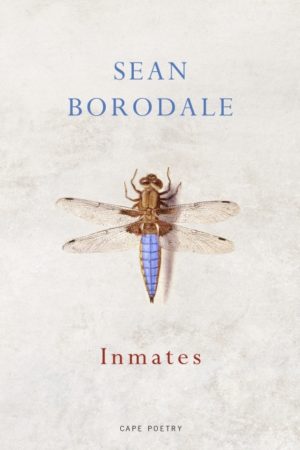Inmates
by Sean Borodale
reviewed by G. C. Waldrep
Sean Borodale is a poet of intense, even obsessive attention. In Bee Journal, he charted his failed attempt to foster a hive; Notes for an Atlas is a flaneur’s Baedeker of walking; Asylum is a cycle of poems about caverns and caves. In his fifth collection, Inmates, Borodale returns to insects. A friend of mine differentiates this as “his bug book” (as opposed to “his cave book”), but that’s not quite right; it’s precisely the lack of attention implied by the term “bug” that Inmates is meant to combat. “Do you forget how to look?” the speaker asks in “Death Place of a Small Tortoiseshell under its Food Source, the Nettle.” We are meant, in Inmates, to pay attention to small life and to do so intelligently. We are meant to pay attention also to disappearances: the disappearance of insect species in our moment of ecological crisis, as well as disappearances more generally, including our own.
Every poem in Inmates has a title that cues the insect(s) in question: “Hawk Moth & Queen Wasp,” “Maggots at the Back of a Cupboard,” “House Flies,” “Wood Shed Wood Pile Insects Roused,” “Double-lobed Moth.” The situations are not for the squeamish: we get “Brimstone Moth, Alive” as well as “Brimstone Moth, Dead,” “Sixteen Hours of a Wood Wasp Encounter,” “Pale Gestating Centipedes under Rotting Bark of Stacked Cherry Wood,” and “Tick Hatchery,” the longest poem in the collection. Casual weeding in the garden becomes a “gash I have made” that produces a “microbial / rush,” a soil that “boils like dark milk, // as meaningless as a clock”: it is a “weltering,” a “brimming,” ultimately “a wound that crawls.”
What we get, gradually, is a sense of radical coinherence. Borodale explains that all these poems are set in and around his home, where he and the insects in question are coresident. Borodale and his insect subjects are in a hierarchical relationship in terms of their poem-bound subjectivity, but as entities—as beings—they are, as the title suggests, inmates, bound together in time and place.
What is radical about this is how vertiginously Borodale’s lyrics plunge into not the accuracy of the insect life but the language we use as an interface between knowledge, experience, and the nonhuman other. There’s something chiseled, lapidary in Borodale’s approach to language that brings to mind Ted Hughes at his craggiest; lines and stanzas of these insect poems feel bitten-off. To read the poems aloud is to give the more unfamiliar muscles of one’s face and throat a workout. Borodale never fully elides his own presence as a thinking being, an intelligent observer whose language leaves a record—a trace—different from the traces left by the insects in birth, passage, and death. If the “welter” of life is “meaningless,” it is also dense with detail, and it is this density of detail that Borodale demands of his language.
In Borodale’s telling, mayfly nymphs are “Bandages of flesh,” “Bodies in tourniquet [ … ] / Growing towards wings.” Moths arising from grass in advance of a lawnmower are “Bony papers that resurrect lightly”: they rise in advance of the mower and descend again “into the vaults of their undertow. // Down, into the hospital / of unmentioned anniversaries; / unmarked births.” In “Insect Eggs Over-wintering,” we are told, “Here is the sleeping time, / the closed membrane of the egg — / half of eternity’s symbiosis.” Fair enough, in a tradition that includes Clare, Hopkins, and Muir, but what follows—Borodale’s meditation on what winter means for the insects in question—feels wholly fresh to me:
This is how winter stores its greater proportion,
in preoccupation:
packets of forming anatomy;
cells in patterns almost to patents;
insect of this;
the consolation of the unremembered
hidden, hereabouts — in pre-citizenship.
As an evocation of winter, this is extraordinary. The “pre-citizenship” of the unhatched eggs is the latch from which the book hangs as a whole. Borodale does not so much plead on behalf of insect citizenship as enact it through forty-nine exquisite portraits.
In moments, the poems achieve an existential sublimity unlike anything else in contemporary poetry. These are suggested by some of the titles: “Autopsy of Fugitive Energy from a Dying Dragonfly,” “Devil’s Coach House Beetle slowly through a Moment of Witness,” “Voice Residue of a Mayfly at the Site of its Empty Exoskeleton.” In “Autopsy of Fugitive Energy from a Dying Dragonfly,” Borodale cues “The quiet technology of its sashed waist” and “The injured stump of its tail” that “burns / like metal that cannot cool yet.” Under the poet’s gaze “paramedic proximity” becomes “My violent / freedom’s final capacity”; the eponymous “Cobweb a.m.” is figured as “A compass of hunger, / a madrigal of waiting.” There are instances that recall not Hughes but Plath: the opening stanzas of “Ladybird (dead on a Lampshade)” read
It takes months, years,
to seal a biography:a shawl of dust,
a closure of self.
Every page, nearly every stanza of this collection bears such treasures.
As I close this remarkable book a second time, I am thinking less of Plath’s famous bee poems than of the equally fine journal entries that preceded them: the intelligence, coupled with avid attention, indeed a cascading attention that encompasses all actors, human and nonhuman. The drama in Borodale’s insect poems is not Borodale’s, despite his presence and yearning. It’s the drama, to collapse Heidegger into Levinas, of watching the Other other and of discovering that in so doing—in one’s own, most exquisite language—one others oneself in the best ways.
Published on May 24, 2022

